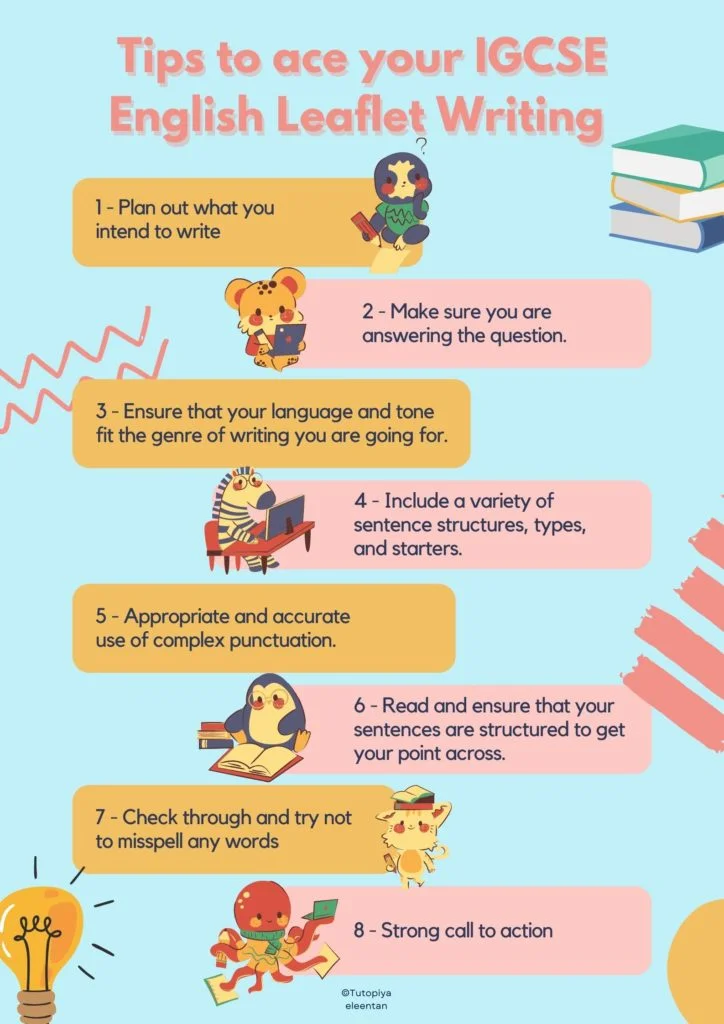
All you need to know about IGCSE Journal writing: IGCSE English Leaflet Writing
One of the easiest ways to score for the IGCSE English Language is tackling Paper 1 which is also known as IGCSE English Journal. The IGCSE English Journal can require students to write a leaflet to convey a message. Hence, today, Tutopiya will run through all you need to know to perfect the IGCSE English Leaflet Writing.
Read also: IGCSE English – Tips for Reading and Writing + Exam Resources
What is IGCSE English Journal?
The IGCSE Journal is an entry that is written by a writer that recounts the events that happened in their life. It also includes their thoughts, emotions, ideas, and beliefs. The IGCSE Journal Writing is part of the IGCSE English Language.
About IGCSE English Leaflet Writing
IGCSE English Leaflet Writing can be present in IGCSE English Language Paper 1 which is a written paper consisting of 20% of the total grade. Paper 1 is a one-hour paper and requires students to complete 2 written tasks. Candidates will be asked to write any two of the following text types:
- Letter
- Article
- Leaflet
- Review
- Report
- Speech/Talk
Tackling the IGCSE English Leaflet Writing
Since there are several types of writing that a student may be tasked to write, we will zoom in on Leaflet Writing in this piece today.
Tips to ace your IGCSE English Leaflet Writing
Here are a couple of useful tips for candidates to take away and note with regards to leaflet writing!
1 - Plan out what you intend to write
Use clear headings to separate each section or point and include a topic sentence to allow readers to understand what you are going to convey in this section. Spice up your piece using different sentence structures and tones to convey your message. Leaflets may also contain bullet points and slogans!
2 - Make sure you are answering the question. (What is the purpose?)
Be clear about what you need to write, always refer back to the questions and the purpose of your leaflet.
3 - Ensure that your language and tone fit the genre of writing you are going for.
Are you writing a report or saying a speech? Be sure to take into account how many formalities you need to include when working on different types of writing genres.
4 - Include a variety of sentence structures, types, and starters.
This will show your examiner that you are able to deliver a variety of sentences with the intended effect. This intended effect should evoke a certain emotion, fitting to what you are tasked to write about.
5 - Appropriate and accurate use of complex punctuation.
This will display your skills and ability in writing, showing the examiners that you are capable of using complex punctuation to enhance your writing and make it meaningful for readers.
6 - Read and ensure that your sentences are structured to get your point across.
At the end of your writing, be sure to read through over and over and ensure that your sentences are structured meaningfully. Your sentences should make sense and flow logically and smoothly for readers to understand easily.
7 - Check through and try not to misspell any words
Be sure to check for spelling and grammar errors which can result in unnecessary loss of marks.
8 - Strong call to action
Make sure you finish your leaflet strong with a call to action. Are you convincing your readers to read, attend or buy? What is your intended outcome?
Let’s run through an example together!

Q: Write a persuasive leaflet to educate teenagers to get fit (20 marks)
To start, let’s have a plan. There are several pointers when it comes to writing for examinations and you may be aware of one or two. Let’s use the PAC and PEEL methods to tackle this leaflet!
What is PAC?
PAC stands for, Purpose, Audience, and Context. PAC is usually used at the beginning before writing. Students should identify the PAC of text to have an idea of where to begin. Let’s give it a go!
Purpose: What is the purpose of the leaflet? To persuade.
Audience: Who is the target audience? Teenagers.
Context: Promoting exercises to get teenagers fit and healthy
What is the PEEL method?
PEEL stands for, Point, Explanation, Evidence, and Link. PEEL is usually used to convey one section of the essay or give a rough idea of the essay. (in this case, the leaflet). PEEL helps to organize ideas and thoughts into 4 simple and digestible parts. Let’s give it a shot!
Leaflet structure
| Introduction | Point: Purpose of leaflet |
|---|---|
| Body | Explanation: Benefits of getting fit for teenagers |
| Evidence: Impact that it can have (make sure it relates to the teenagers!) | |
| Conclusion | Link: Conclude with a call to action and include contact information |

Written by
Tutopiya Team
Educational Expert
Related Articles

Which Is the Toughest Subject in IGCSE and How Can You Overcome It?
Tackle tough IGCSE subjects! Discover the hardest IGCSEs and get expert tips for success in Maths, Physics & more, essential for IB & A-levels.

Is 6 Months Enough to Prepare for IGCSE Exams?
Comprehensive guide and expert insights on educational topics for IGCSE, IB, and international curriculum students.

A-Level and IB Students: 6 Steps to Nail Your University Application
A-level & IB students: Nail your university application! Get expert tips on building a winning application for top international unis.


